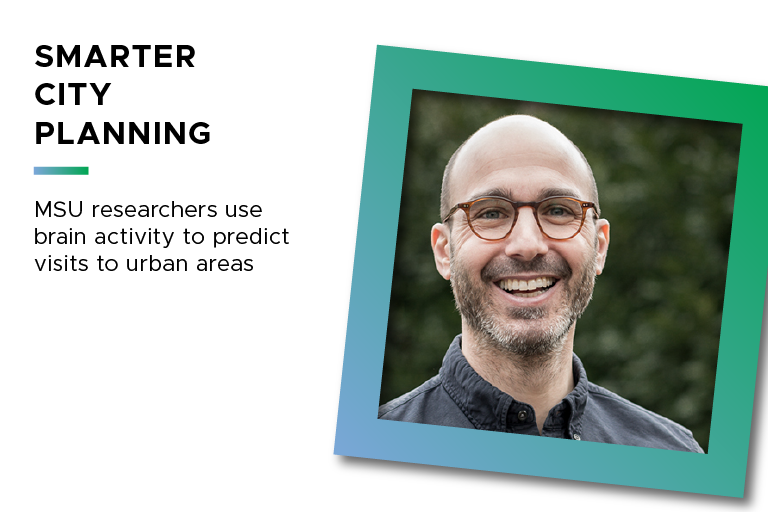Story adapted from an article originally shared on MSUToday.
Dar Meshi, an associate professor in the Department of Advertising and Public Relations and the director of the Social Media and Neuroscience Lab, led a study where they used brain activity to predict visits to urban areas. The study, which was recently published in the journal Nature Cities included collaborators from the University of Lisbon in Portugal. Together they found that the brain's reward system can shape human behavior within urban environments and help in designing cities that promote sustainable living.
Urban areas typically offer better access to educational and employment opportunities along with a variety of additional benefits, but due to the swift pace of urbanization, they also give rise to challenges such as lack of green spaces, increased traffic noise, and social inequities.
Meshi and his co-authors used principles from the budding field of neurourbanism – the study of measuring the human brain to predict and understand the influence of urban environments on behavior – to conduct the study.
“Neurourbanism has the potential to contribute significantly to the design of cities that prioritize cognitive, emotional and physical well-being,” Meshi said. “By prioritizing the well-being of individuals, cities can create environments that are conducive to the overall health and happiness of their inhabitants.”
Neurourbanism employs brain scanning tools such as functional magnetic resonance imaging (FMRI). Which detects changes in blood oxygen levels, known as the blood oxygen level dependent, and uses this signal to identify the brain regions that are active during mental processes.
Meshi and his colleagues focused on the ventromedial prefrontal cortex (vmPFC).
For this study, 77 participants in the U.S. who had never visited Lisbon, Portugal, underwent fMRI scanning while viewing and rating photos depicting urban environments in the city. The density of photos for each region served as a proxy for measuring visitation patterns around Lisbon.
The findings from the study suggested that the neural activity in the vmPFC can predict people’s visitation patterns to or away from a specific environment.
“People typically make decisions to maximize value, and because certain urban areas induce greater value-related brain activity than others, people in the city are more likely to travel to, or take pictures of, those certain areas,” Meshi said.
According to Meshi, the results of the study imply that the vmPFC may be involved in processing a range of value judgements within urban environments, including perceptual, cognitive, social and cultural values.
“Individuals may be drawn to visit urban spaces not only because of their aesthetic appeal, but also due to their sociocultural relevance,” he said. “This could include places with historical significance or social importance, which may not necessarily be aesthetically pleasing, but still hold considerable value.”
One of the study's authors Ardaman Kaur, a postdoctoral researcher in the MSU Institute for Quantitative Health Sciences and Engineering, said this research shed important light on how our brains may encode information related to urban environments and drive visits around these environments.
Building on this insight, Meshi is confident that the neurourbanistic approach implemented by his team can help improve urban planning strategies, ultimately fostering enhanced livability and well-being.
“By incorporating these findings into the urban infrastructure and services, we may be able to create cites that are more efficient and enhance population livability and make it easier for residents to get from place to place,” he said.
By Logan Chrisinske
